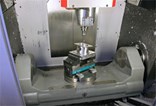Aerospace Subcontractor Increases Five-Axis Machining Capability

Hants, UK - An established practitioner of five-axis machining for the production of medium-size aerospace parts, Oldland CNC wanted at the beginning of 2006 to extend its use of the technology to manufacture smaller components falling within a nominal half-meter cube. From a shortlist of five 40-taper machines, the Bristol subcontractor chose a German-built Hermle C 600 U vertical-spindle machine with 600 x 450 x 450mm working envelope and 30-tool magazine. It was supplied in March 2006 through sole UK agent, Geo Kingsbury Machine Tools. 
Whereas Oldland CNC extensively uses fully interpolative five-axis profiling for producing aircraft parts that incorporate complex surfaces, full five-axis machining on the Hermle accounts for only 10 percent of production. The remaining 90 percent is 3+2-axis work, with two axes clamped while the others perform the cutting cycle.
Commented Managing Director, John Tucker, "Smaller aluminium brackets on aircraft do not generally include complicated features needing full five-axis machining. However, simpler geometries benefit just as much from being milled on five sides in one hit using a five-axis machining center rather than in several set-ups on a three-axis machine.
"We regularly evaluate components being produced on our three-axis machines, looking for parts that will benefit from being positioned under CNC in a sequence of compound angles on the Hermle and milled using the other three axes. This approach can save one or two re-clampings and subsequent operations, leading to significant savings in production costs, particularly for larger batch work."
Steve Hayes, Engineering Manager, suggests that moving all five axes simultaneously should be a last resort, as any five-axis machine runs more productively in five-axis mode. Complex calculations that the control has to carry out prevent the use of fast feed rates in full five-axis profiling. Furthermore, the machine is only as quick as its slowest axis, usually the rotation of the table, so if that is one of the axes that are clamped, machining speed is increased.
High accuracy is a priority at Oldland CNC, a co-ordinate measuring machine being used for inspecting every component before delivery. A feature of Hermle machines that Mr. Tucker particularly likes, and believes promotes precision machining, is the mineral casting that forms the bed. It has good dynamic stability and up to 10 times better vibration damping characteristics than steel or cast iron, especially at high spindle speeds and feeds.
"It is not a finely powdered mineral either – you can see large pieces of granite embedded in the compressed matrix if you look at a cut-away section of a bed in the Hermle factory, as we did," he advised.
Another design attribute he appreciates is Hermle's patented arrangement of three staggered Y-axis guideways, one of which is positioned between two outer ways and set further back. This effectively halves the span and gives stable traverse due to three-point support combined with a single drive in line with the central carriage on the gantry.
"The name of the game when producing high accuracy components, especially large ones, is not repeatability but volumetric accuracy of the machine tool," continued Mr. Tucker.
"Manufacturers are often reluctant to disclose it, content to quote positional accuracy and repeatability in their catalogues. Interestingly, Hermle does not appear to publish any accuracy figures at all; perhaps they do not need to."
"In any case, for all of our machine tools we measure volumetric accuracy ourselves using a calibration ball and probe in the spindle. It is the only way to determine how accurate features in a component will be, relative to one another, if they are machined in diametrically opposite corners of the working area. When we checked the C 600 U, it had a total volumetric accuracy of 50 microns over the entire machining envelope, which I regard as excellent for a machine of this size moving in five axes."
A majority of work going through Oldland CNC's machine shop is for the Airbus family of aircraft – A300/310, A320, A330/340 and A380. Round-the-clock operation continues from 6.00 am on Monday until 4.00 pm on Friday. The Hermle's maximum 16,000 rpm spindle rotation is frequently used, although 12,000 to 14,000 rpm is more usual, the elevated speeds enabling cutting feed rates between 5 and 10 m/min, leading to high metal removal rates. (A 40,000 rpm spindle is optionally available on this machine). Productivity is further enhanced by acceleration of 5 m/s2 to 35 m/min rapid traverse in all linear axes, and 5.5 seconds chip-to-chip time.
When asked why he opted for a Hermle machining centre rather than one of the others on the shortlist, Mr. Tucker cited three main reasons. First, the ± 115 degree swivelling trunnion carrying the 280 mm diameter rotary table is an integral part of the machine construction, with the trunnion bearings set directly into the sides of the bed casting. Some other machines offered a less robust solution involving a two-axis compound table bolted to the bed.
Secondly, all 24 machining centers on the shop floor have Heidenhain controls, so to facilitate operators swapping between machines, the new VMC had to be fitted with a control from that supplier – in this case the Ethernet-enabled Heidenhain iTNC 530 (although the Siemens S840D is available as an option). Computer-aided engineering software in use at the Bristol site for off-line program generation includes Catia V5 CAD, MasterCam and CG Tech's Vericut for simulation and tool path verification.
The third reason given for choosing Hermle was Geo Kingsbury's good reputation for after-sales service, which has been confirmed in the first nine months of C 600 U ownership, according to the company.
SOURCE: Geo Kingsbury Machine Tools Limited
